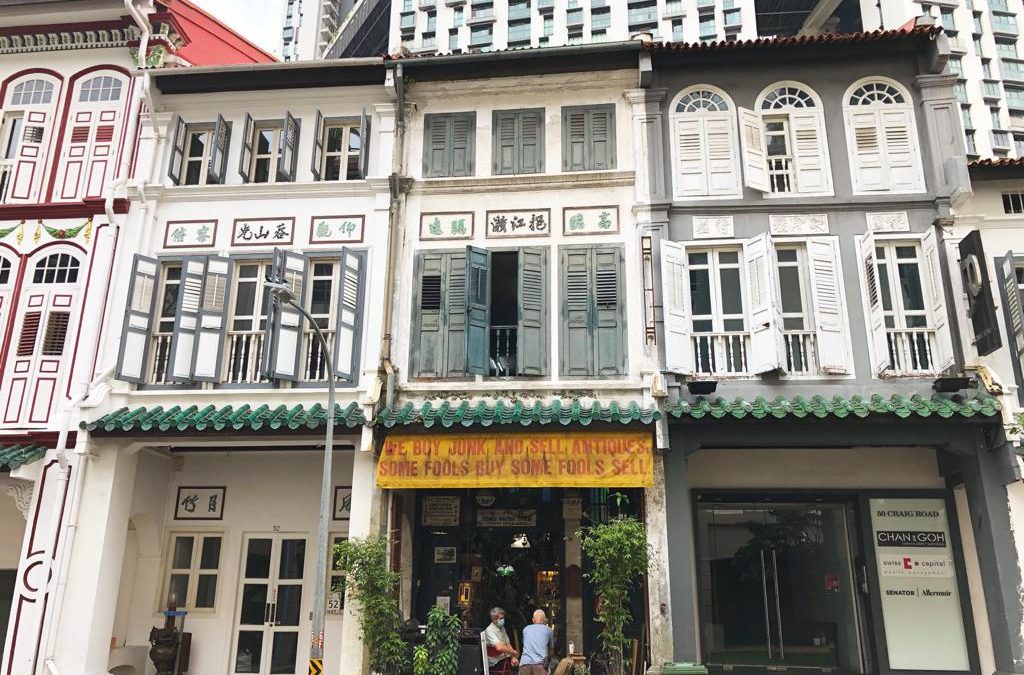A shophouse is a type of building that can be found in Southeast Asia that dates back to the 1800s. The styles of shophouses have evolved over the years with different unique characters depending on the location and period, but they share some common characteristics.
Shophouses are usually low-rise (2 to 3 storeys) with a narrow face and long length. They have the iconic five-footway mandated by Sir Stamford Raffles in 1822, to protect people from sun and rain. There is also an airwell inside that is exposed to the sky that helps to facilitate lighting and natural ventilation. The bottom floor is often designed for commercial use such as a shop or restaurant while the upper floors are used for residential.
Where are the shophouses located in Singapore?
The first shophouses in Singapore are located by South Bridge Road and New Bridge Road, built in mid 1840s. The pedestrianization of Emerald Hill Road in 1981 was one of the key milestones in the government’s conservation effort. In 1989, the government listed over 3,200 buildings in 10 areas for conservation, most of which were shophouses – Chinatown (Telok Ayer, Kreta Ayer, Tanjong Pagar, Bukit Pasoh), Little India, Kampong Glam, Singapore River (Boat Quay, Clarke Quay), Cairnhill and Emerald Hill.
Aside from the central area, shophouses with distinctive Peranakan influences can be found in Joo Chiat while the shophouses in Holland Village definitely puts you close to the nightlife scene, especially during pre-covid times.
Can foreigners purchase a shophouse in Singapore?
Foreigners are allowed to purchase a shophouse listed for commercial use but they are required to seek for approval prior to the purchase of a shophouse listed for residential use. There are other types of properties that foreigners require pre-approvals before buying such as terrace houses and bungalows, read more about it on the Singapore Land Authority website if you are interested.
Is it worth buying a shophouse in Singapore?
The value of shophouses has been increasing over the years, mainly because of its scarcity. As these buildings have been built long time ago, they have the luxury of space as compared to the newly-built. Most shophouses are situated close by or within the CBD area, so it is great for investment as many businesses like to rent and convert them to their working spaces. Some companies renovate shophouses and lease them as commercial spaces, such as 8M Real Estate and The Working Capital. There are also more and more shophouse owners renting their unit as co-living spaces and the responses have been great. For instance, Figment is a platform where people rent studios in shophouses for co-living.
Many shophouses were given the conservation status by URA. That means plenty of restrictions are in place when it comes to renovation and installation in the unit. For instance, approval is needed before the installation of air-conditioning. However, it is also likely that the government will leave the area untouched while implementing new plans around the city, such as building of new MRT stations, so there will be no construction noises around.
In short, it is definitely worth buying a shophouse as a long-term plan and the touch of nostalgia in these buildings only adds on to its value.
How much does a shophouse cost?
Demand for shophouses has been high due to limited supply and prices of shophouses have been increasing. According to URA, sales of shophouses made in 2020 is 10% more than in 2019. In 2020, 2 shophouses on Amoy Street were sold for $29.8 million each. Those were also the top shophouse deals for the year. In general, prices of shophouses range from $10 million to $20 million, depending on its location and condition.
Depending if the property is listed as residential or commercial, the amount of payable property tax varies. For the purchase of a residential unit, foreigners are required to pay 20 percent of Additional Buyer’s Stamp Duty (ABSD) on top of Buyer’s Stamp Duty (BSD) which goes up to 4 percent, depending on the price of the property. However, ABSD is not needed on the purchase of a commercial unit, even for foreigners. We wrote a post talking about BSD and ABSD on our blog and Instagram post, check them out if you are interested!

